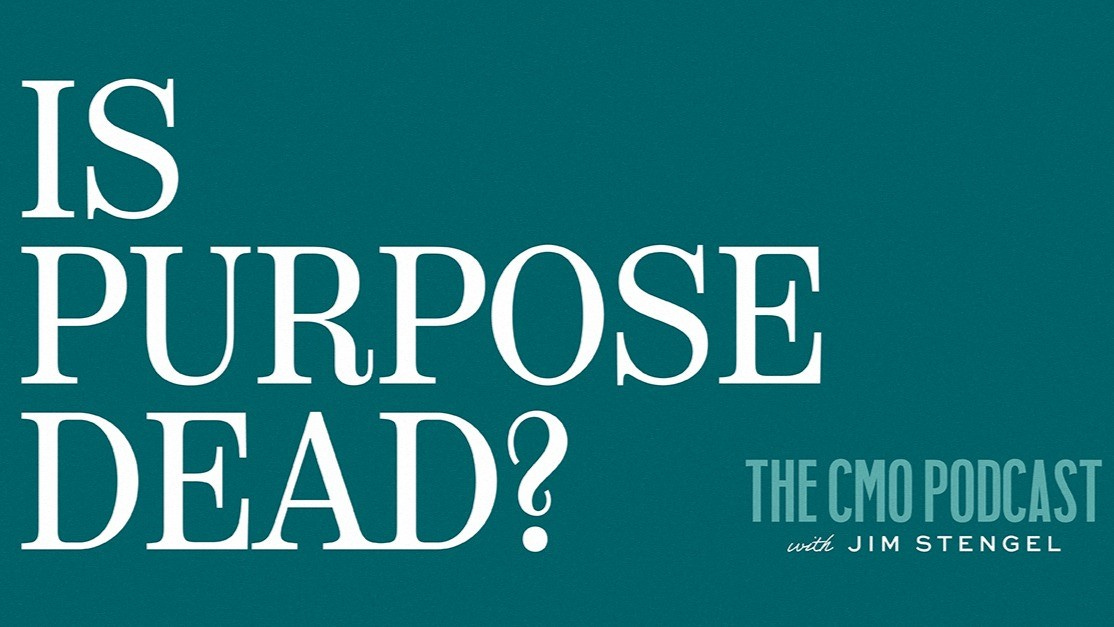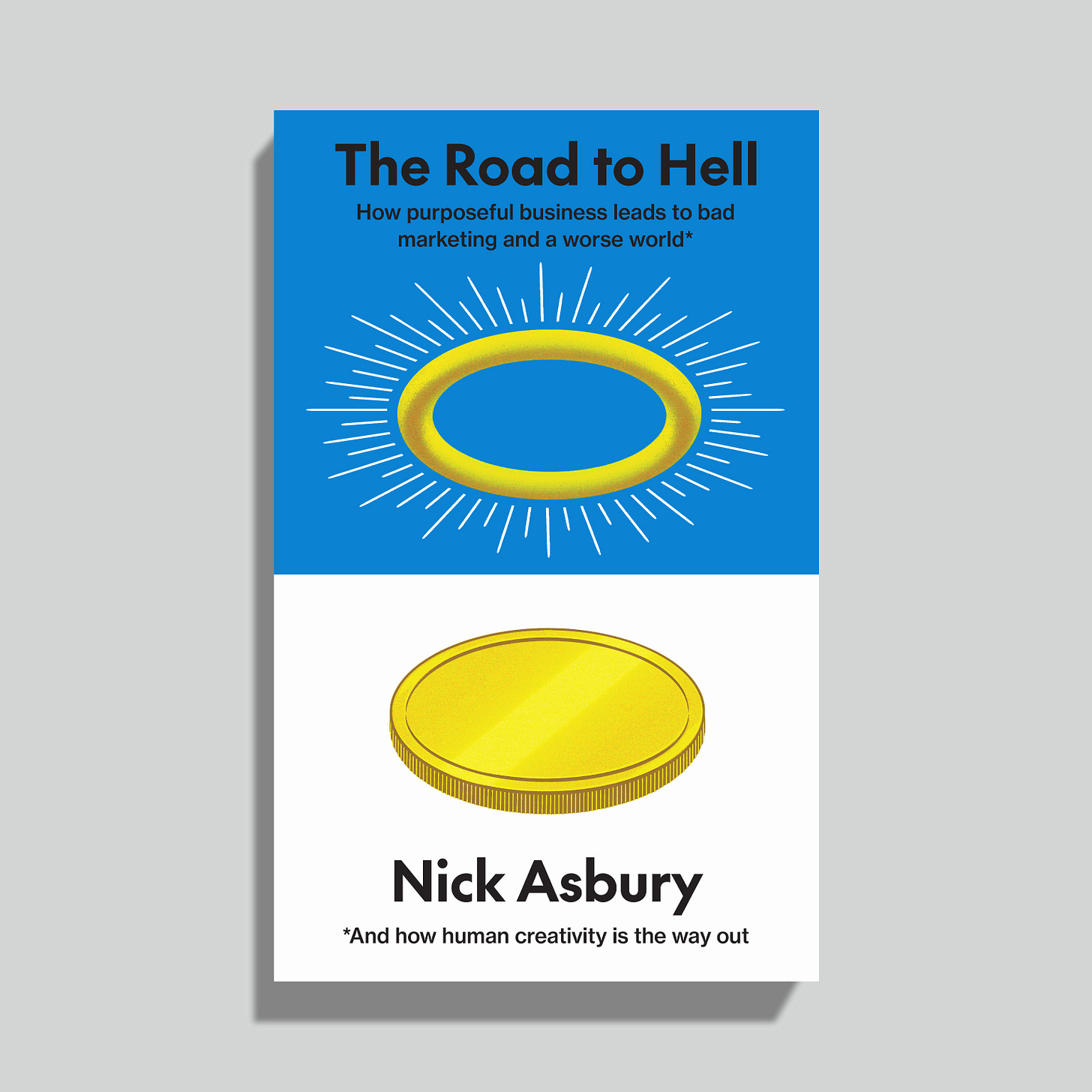Stengel and a strange purpose autopsy
Despite omissions, a recent purpose conversation on the CMO podcast was at least 50% sane—and might be the closest we get to closure
I’ve taken a few months away from Substack to immerse myself in research for a new book about writing, creativity and AI—more on that when it happens.
At the same time, I’ve found myself cooling on the purpose wars, given the sense that the vibe has conclusively shifted. There’s still some bizarre revisionism around, like people heralding Philip Kotler’s ‘announcement’ of purpose being the new ‘Fifth P’ in marketing as a major breakthrough, despite the fact he’s been reheating that article since 2013. But for anyone more closely attuned to the debate in the corporate world, it feels like purpose is finally fading, like a strange fever dream.
Still, I couldn’t help being pulled back in by a new CMO Podcast episode from Jim Stengel. It features Kory Marchisotto, CMO of e.l.f. Beauty, Lisa Materazzo, CMO at Ford, Mark Ritson, marketing professor and commentator, and Sarah Carter, Global Planning Partner at adam&eveDDB. Broadly, Marchisotto and Materazzo make the case for purpose, while Ritson and Carter push back.
But it’s the host who first catches the eye. As any reader of The Road to Hell knows, Stengel was the author of Grow: How Ideals Power Growth and Profit at the World’s 50 Greatest Companies. Published in 2011, the book became one of the most influential texts in the early purpose years, endorsed by Sheryl Sandberg and Martin Sorrell, and widely cited as proof that purposeful brands out-perform the market.
In his post announcing the podcast episode, Stengel confirms his part in the purpose narrative: “I have long championed the belief that brands grow by serving a higher purpose beyond the functional benefit of their products or services. I believe organizations that create products, services, and experiences that improve people’s lives differentiate themselves and win versus the competition.”
But, in Stengel’s telling of the story, the pushback has only just begun: “As people grow more skeptical and some brands struggle to connect their lofty language to real value, a quiet question is starting to echo through company boardrooms and agencies: Has brand purpose run its course?” According to Stengel’s version of events, purpose “has entered a more mature and more scrutinized phase”.
In reality, the scrutiny began long ago. Way back in 2011, Professor Byron Sharp, known for his rigour on these questions, subjected Stengel’s methodology to clear-eyed scrutiny and found it fundamentally flawed. As far as I’m aware, Stengel has never responded to this ‘quiet question’, posed 14 years ago.
The question echoed louder in 2015, when author and behavioural scientist Richard Shotton wrote a widely shared critique of Stengel’s work, versions of which appeared on Medium, WARC, Huffington Post and The Drum.
Again, this was a high-profile critique, raising substantive questions. To my knowledge, Stengel has never addressed them. Despite offering spirited pushback throughout the podcast, both Sarah Carter and Mark Ritson were too polite to take Stengel directly to task on this. But it’s hard to take the purpose ‘conversation’ seriously when one side appears so wilfully unaware that the conversation even has another side.
The true history of this ‘conversation’ is one of increasingly impatient pushback from the saner corners of the business world. Marketing Week was running purpose-sceptical articles as early as 2013, when Marketoonist was also lampooning it (above). The Guardian was running Dove-sceptical articles in 2015. Mark Ritson started attacking brand purpose in 2015. I was writing about the mission escalation trend in 2015, before properly entering the purpose fray in 2017. Anand Giridharadas dissected the ‘do well by doing good’ cult in Winners Take All in 2018. Steve Harrison wrote his scathing critique in 2020.
Jim Stengel now welcomes what he calls a ‘timely conversation’. But it’s one that could have been had at least 14 years ago, if he and many others had engaged with the criticism in good faith, rather than ignoring it, or problematising it as somehow reactionary or ethically suspect. (As far as I know, Stengel has never done the latter—he seems a pleasant guy and more oblivious to the purpose debate than anything else.)
All this means his latest podcast lands strangely and unsatisfyingly. But it’s still immensely heartening to hear the unequivocal pushback from Mark Ritson, who talks witheringly of the “undergraduate desire to link purpose to making money”, eyerolls at the “orgy of purpose” at Cannes, and rightly repeats his line that “the purpose of purpose is purpose”. Ritson has long been clear about this: Many businesses have done good things over the years, without making it the centre of their brand image. When they do, the ‘good’ starts to look a lot like self-interest. Early purpose critic Jesus Christ had it right when he said “Thus when you give to the needy, sound no trumpet before you, as the hypocrites do… that they may be praised by others.” (Matthew 6:2) The din of for-profits blowing their purpose trumpets is what first provoked me into joining this debate way back when. It’s moral grandstanding of the most counter-productive, self-deluding kind, and there’s still plenty of it around (more on that in a minute).
Sarah Carter, who entertainingly floated the idea of a Purpose Inquiry a few months back, was also admirably sane, bringing in the crucial Bill Bernbach quote—“A principle isn’t a principle until it costs you something”—and talking with disbelief about a group of Gen Z marketing trainees who were surprised by the news that price and placement are more important factors than politics when it comes to most purchasing decisions.
As is inevitable in the social dynamics of these situations, both Carter and Ritson were also keen to extend olive branches. The position that purpose is nonsense except for a handful of heroic exceptions like Patagonia, e.l.f., and Ben & Jerry’s is a tactful one to adopt, because it allows every purpose advocate to think they’re one of the exceptions. For the sake of a quiet life, I’d be tempted to go along with it, certainly in a podcast setting. Sure, attaching yourself to some social issue in a way that’s sufficiently authentic might help drive salience and carve out some distinct piece of mental territory in a few cases—go for it, all hail Patagonia etc.
But for anyone inclined to linger on the moral, societal and political questions, even that position gets uncomfortable fast. Mark Ritson is forced to be uncharacteristically credulous when he praises how being purposeful “cost Patagonia everything”—as though Chouinard and his family have been cast into poverty, rather than locking in political influence for generations, while avoiding millions in inheritance tax and being hailed as saints in the process.
Similarly, it’s tempting not to look too closely at Ben & Jerry’s and think: good for them, nice causes, sold plenty of ice cream, everyone’s a winner. But the problems are clear for anyone who wants to see. Ben Cohen’s recent friendly chat with Tucker Carlson must cause some cognitive dissonance for purpose people. In the podcast, he talks about his contrarian position on the west inviting the Ukraine war through reckless UN expansion—a take that most purpose people probably don’t share, but which you’ll be endorsing next time you buy your Cherry Garcia, along with their position on ceasing all business in the Palestinian territories. All this is assuming founders Cohen and Greenfield are successful in buying their company back from Unilever, with whom they had a strained agreement to retain control of their ‘social purpose’, while enjoying all the advantages of a multinational parent company. Some might also ask whether increasing the sales of HFSS foods can ever be a socially positive thing, given rising levels of obesity. This might seem like an unfair burden to place on a company, but when you advertise yourself as a proof case of ‘doing well by doing good’, you have to weigh up the ‘doing good’ side of the ledger.
As with ice cream, so with peanut butter. Early in the podcast, Jim Stengel relates his first glimmers of purpose awakening during his time with P&G and the Jif peanut butter account. As he describes it, it was a ‘stalemate’ brand until he decided to look into the values of parents and children and ‘make a difference through our brand with what they care about’—which in turn led to Jif building links with parent-teacher associations, schools and daycare centres. All this is presented as self-evidently a good thing, with great commercial results. But is that how society sees it? From the early days of the campaign, parents and policy makers were concerned. A 1990 article headlined ‘Corporations invade the schools’ noted how Procter & Gamble was offering schools money for Jif labels collected by their students, while running ads saying: ‘The more you buy, the more we’ll give to America’s schools.’ Is that doing well by doing good, or just doing well by marketing to children, while federal regulators do the slow work of curbing corporate involvement and improving health outcomes?
So often, a version of this logic seems to play out in purpose case studies. With sufficient rigour (which is rare), it’s possible to measure some of the commercial outcomes. But there’s a profound lack of curiosity about the true social impact, at least once you step outside the perspective of the company and think in terms of the society it’s claiming to help. Given that marketers are working inside the company and feel sincerely that their intentions are good, there’s a natural tendency to think this must equate to good outcomes—and commercial success is taken as positive proof.
I’ve experienced this myself with some brands I’ve worked on. You can find yourself developing a kind of Stockholm syndrome—a psychological phenomenon first noticed in hostage situations—where you develop positive feelings about the brand currently holding you captive (i.e paying your rent), coming to identify yourself closely and even passionately with the brand and its goals.
I can’t help noticing this in the contributions of the two other guests on the podcast, who come across as smart people and clearly successful marketers. But both speak almost evangelically about the social values of their employers (Ford and e.l.f), to the point where you’d think they were working for the Salvation Army or Cancer Research.
I’ve no doubt Ford has contributed significant social good over the years—selling affordable cars, employing generations of autoworkers, donating to charities, paying taxes, and driving it all with strong, mass-market advertising. You can go back through the history and pick out achievements to weave into a purpose story, like being early on the introduction of a living wage. But if you’re going to do that, it’s only honest to note all the stuff on the other side of the ledger—the unfortunately strong historic links with anti-semitism, the union-busting, the emissions scandal, the greenwashing. None of it means Ford isn’t a great American company. But the idea that its values of “trust, community, capability and passion” reside deep in some unchanging corporate soul and will define “what we have been and what we will continue to be for the next 120+ years”? It’s all marketing speak. It’s not real.
As for e.l.f. Beauty, I recommend this video, which is presented far better than I could manage (I suppose I could have a shave). It’s far from a hit piece and positive on the whole, but it also tells a story of questionable commercial practices combined with shameless moral grandstanding. It’s good on how e.l.f has built its brand on ‘dupes’ that mimic popular high-end products, then ruthlessly undercut them in price. This is framed as ‘democratising’ beauty—as a copywriter, I know this is the cool way of saying ‘making it cheaper’. As the video points out, one of the reasons e.l.f is able to afford this is that it doesn’t have to invest in the product development and hit-and-miss experimentation that leads to the breakthrough products that e.l.f then copies. From the start, the company was also what you might call patriarchal in nature—two young male founders backed by one of their fathers, an entrepreneur with inside knowledge at Target. In 2014, they sold a majority stake to private equity firm TPG, whose founding partner Bill McGlashan later had to leave the e.l.f board after getting caught paying bribes to get his son into college.
e.l.f not only glides away from such criticisms (and class action lawsuits), but has the chutzpah to spin them round into moral superiority, launching a campaign that challenges its rivals to ‘dupe’ their loudly trumpeted ethical practices. It urges other companies to democratise their products by dropping the price, which must grate with the brands whose products have been copied, or the non-VC-backed indies who don’t have the distribution in Target. It further urges them to embrace a ‘double’ cruelty-free certification, which (as the video notes) isn’t as rare as e.l.f makes it sound. And it challenges them to increase boardroom diversity, boasting that their own board is now 66% female and ‘44% diverse’ (this seems to be how we talk now—some people are ‘diverse’ and others aren’t).
I’m not setting out to paint e.l.f. or anyone else as some terrible company—they’re not. There are many great lessons to learn from them. They’re proof of a timeless principle in marketing: if you can find a way to sell a high-quality product at a low price, then you’ll go far, no matter who’s on your board. It’s a classic exploitation of a market gap backed by smart branding, nurturing of distinctive assets, and ventures into music, film, media and beyond. Those are stories worth exploring, but instead they get lost in this haze of ‘It’s all down to the purpose—#DoBetter everyone!’
It was wrong in 2013, and it’s wrong now. And the cumulative effect is serious. When so many brands and agencies drink the same Kool-Aid, it leads to worse marketing (because the entire mental model is warped), and a worse world (because real social good gets obscured and obfuscated by corporations who inevitably protect their self-interest and highlight the issues least threatening to them).
All the while, the purpose movement blurs distinctions on which the future of humanity may depend. Right now, there’s a debate raging about OpenAI trying to escape its non-profit status—a tangled story involving concepts like non-profit, for-profit, capped-profit and public benefit corporation. For now, suffice to say the debate only exists because everyone knows the distinctions matter, fundamentally changing the incentive structure by which organisations operate, and consequently how this powerful technology evolves. Purpose obscures all of it—just go for-profit, write a purpose statement, but make sure it’s authentic and you really, really mean it.
Bullshit.
Anyway, speaking of high-quality products at a low price.
Thanks for reading. By the way, I’m appearing on a Zoom with some semioticians on Friday 30 May, talking about ‘The rise of the right’. Free sign-up here.











Looking forward to the next book!
You’re right that the “quiet voice” questioning Brand Purpose has been around far longer than Jim Stengel implies. And it wasn’t just the well-known commentators. Plenty of people getting on with their work in strategy, creative and marketing felt uneasy about the idea. In a blog post from 2008, I wrote:
'For a good few years now, we've seen a lot of "Brand Aid" brands find their insight (no little piddly "product insight", this, but the huge holy grail of a "category insight"), pump it up into a Cause and go forth to Save the World with their Brand.’
As you say, a strange - and rather prolonged - fever dream.
Too good, thanks again Nick. Not sure I’m thrilled to see your crusade coming to an end quite yet 😊. Thanks for fighting the good fight mate.